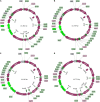Expansion of Cyclophyllidea Biodiversity in Rodents of Qinghai-Tibet Plateau and the "Out of Qinghai-Tibet Plateau" Hypothesis of Cyclophyllideans
- PMID: 35211102
- PMCID: PMC8861457
- DOI: 10.3389/fmicb.2022.747484
Expansion of Cyclophyllidea Biodiversity in Rodents of Qinghai-Tibet Plateau and the "Out of Qinghai-Tibet Plateau" Hypothesis of Cyclophyllideans
Abstract
The Cyclophyllidea comprises the most species-rich order of tapeworms (Platyhelminthes, Cestoda) and includes species with some of the most severe health impact on wildlife, livestock, and humans. We collected seven Cyclophyllidea specimens from rodents in Qinghai-Tibet Plateau (QTP) and its surrounding mountain systems, of which four specimens in QTP were unsequenced, representing "putative new species." Their complete mitochondrial (mt) genomes were sequenced and annotated. Phylogenetic reconstruction of partial 28S rDNA, cox1 and nad1 datasets provided high bootstrap frequency support for the categorization of three "putative new species," assigning each, respectively, to the genera Mesocestoides, Paranoplocephala, and Mosgovoyia, and revealing that some species and families in these three datasets, which contain 291 species from nine families, may require taxonomic revision. The partial 18S rDNA phylogeny of 29 species from Taeniidae provided high bootstrap frequency support for the categorization of the "putative new species" in the genus Hydatigera. Combined with the current investigation, the other three known Taeniidae species found in this study were Taenia caixuepengi, T. crassiceps, and Versteria mustelae and may be widely distributed in western China. Estimates of divergence time based on cox1 + nad1 fragment and mt protein-coding genes (PCGs) showed that the differentiation rate of Cyclophyllidea species was strongly associated with the rate of change in the biogeographic scenarios, likely caused by the uplift of the QTP; i.e., species differentiation of Cyclophyllidea might be driven by host-parasite co-evolution caused by the uplift of QTP. We propose an "out of QTP" hypothesis for the radiation of these cyclophyllidean tapeworms.
Keywords: Cyclophyllidea; Qinghai-Tibet Plateau; biogeography; phylogeny; rodents; species differentiation.
Copyright © 2022 Wu, Dai, Li, Littlewood, Ohiolei, Zhang, Guo, Wu, Ni, Shumuye, Li, Zhang, Fu, Fu, Yan and Jia.
Conflict of interest statement
The authors declare that the research was conducted in the absence of any commercial or financial relationships that could be construed as a potential conflict of interest.
Figures





Similar articles
-
Genetic Evolution and Implications of the Mitochondrial Genomes of Two Newly Identified Taenia spp. in Rodents From Qinghai-Tibet Plateau.Front Microbiol. 2021 Mar 23;12:647119. doi: 10.3389/fmicb.2021.647119. eCollection 2021. Front Microbiol. 2021. PMID: 33833747 Free PMC article.
-
Morphological observation, molecular identification and evolutionary analysis of Hydatigera kamiyai found in Neodon fuscus from the Qinghai-Tibetan plateau.Infect Genet Evol. 2024 Sep;123:105629. doi: 10.1016/j.meegid.2024.105629. Epub 2024 Jun 25. Infect Genet Evol. 2024. PMID: 38936527
-
Phylogeny and biogeography of Primula sect. Armerina: implications for plant evolution under climate change and the uplift of the Qinghai-Tibet Plateau.BMC Evol Biol. 2015 Aug 16;15:161. doi: 10.1186/s12862-015-0445-7. BMC Evol Biol. 2015. PMID: 26275399 Free PMC article.
-
The role of the uplift of the Qinghai-Tibetan Plateau for the evolution of Tibetan biotas.Biol Rev Camb Philos Soc. 2015 Feb;90(1):236-53. doi: 10.1111/brv.12107. Epub 2014 May 1. Biol Rev Camb Philos Soc. 2015. PMID: 24784793 Review.
-
The uplift of the Qinghai-Tibet Plateau and glacial oscillations triggered the diversification of Tetraogallus (Galliformes, Phasianidae).Ecol Evol. 2020 Jan 22;10(3):1722-1736. doi: 10.1002/ece3.6008. eCollection 2020 Feb. Ecol Evol. 2020. PMID: 32076546 Free PMC article. Review.
Cited by
-
Genome-wide phylogenetic and genetic evolutionary analyses of mitochondria in Hypoderma bovis and H. sinense on the Qinghai-Tibetan Plateau.Parasitol Res. 2023 Dec 14;123(1):43. doi: 10.1007/s00436-023-08060-6. Parasitol Res. 2023. PMID: 38095728
-
Identification of the tapeworm Mosgovoyia pectinata (Anoplocephalidae) in Faroese mountain hares (Lepus timidus).Int J Parasitol Parasites Wildl. 2023 Mar 20;21:17-21. doi: 10.1016/j.ijppaw.2023.03.006. eCollection 2023 Aug. Int J Parasitol Parasites Wildl. 2023. PMID: 37025621 Free PMC article.
-
Wood mouse (Apodemus sylvaticus L.) as intermediate host for Mesocestoides canislagopodis (Rudolphi, 1810) (Krabbe 1865) in Iceland.Parasitol Res. 2023 Sep;122(9):2119-2134. doi: 10.1007/s00436-023-07911-6. Epub 2023 Jul 6. Parasitol Res. 2023. PMID: 37410124
-
Complete mitochondrial genome of Scathophaga stercoraria (Diptera: Scathophagidae) in wild plateau pika: genome descriptions and phylogenetic evolution.Parasitology. 2024 Sep;151(10):1075-1084. doi: 10.1017/S0031182024000623. Epub 2024 May 22. Parasitology. 2024. PMID: 39563190 Free PMC article.
-
Helminths of free-ranging dogs and cats in an urban natural reserve in Mexico City and their potential risk as zoonotic agents.PLoS One. 2024 Sep 16;19(9):e0310302. doi: 10.1371/journal.pone.0310302. eCollection 2024. PLoS One. 2024. PMID: 39283874 Free PMC article.
References
-
- Brugal J. P., Croitor R. (2007). Evolution, ecology and biochronology of herbivore associations in Europe during the last 3 million years. Quaternaire 18 129–152.
-
- Cai T., Shao S., Kennedy J. D., Alström P., Moyle R. G., Qu Y., et al. (2020). The role of evolutionary time, diversification rates and dispersal in determining the global diversity of a large radiation of passerine birds. J. Biogeogr. 47 1612–1625.
-
- Caira J. N., Jensen K. (eds) (2017). Planetary Biodiversity Inventory (2008–2017): Tapeworms from Vertebrate Bowels of the Earth. USA: University of Kansas. 463.
LinkOut - more resources
Full Text Sources

